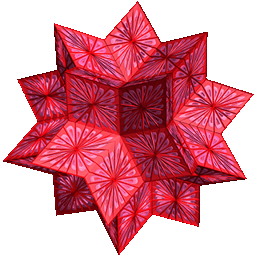Mathematica 14.0.0 by Wolfram

Mathematica is a general computing environment, organizing many algorithmic, visualization, and user interface capabilities within a document-like user interface paradigm.
It was originally conceived by Stephen Wolfram, developed by a team of mathematicians and programmers that he assembled and led, and it is sold by his company Wolfram Research.
Mathematica seamlessly integrates a numeric and symbolic computational engine, graphics system, programming language, documentation system, and advanced connectivity to other applications.
Mathematica combines powerful computing software with a convenient user interface. It is this range of capabilities – many world-leading in their own right – that makes Mathematica uniquely capable as a “one-stop shop” for you or your organization’s technical work.
The features include symbolic and high-performance numeric computation, 2D and 3D data visualization, broad programming capabilities, and one-step creation of web documents. Mathematica’s notebook format allows for the generation of cross-platform, fully customisable files that provide professional mathematical typesetting and publication-quality layout of electronic and printed media.
Wolfram Mathematica 14 Features:
- Vast web of mathematical, visualization, graphics, and general programming functions, typically with state of the art implementations
- Ability to instantly create user interfaces to arbitrary computations by just specifying parameters
- Integrated computable data sources, from chemistry and pure mathematics to city locations and country statistics
- Highly general interface that allows the uniform manipulation and intermingling of graphics, programs, user interfaces
- Support for efficient datastructures such as sparse arrays, piecewise functions, etc
- Support for emerging fields such as graph plotting and analysis, alternate input devices, new data formats
- Ability to create and publish programs that run on the free Mathematica Player
Wolfram Mathematica is split into two parts, the “kernel” and the “front end” . The kernel is the algorithmic engine for performing computations. The front end provides a convenient human interface for creating and manipulating programmatic structures, allowing graphics, mathematics, programs, text, and user interfaces can be freely edited and intermingled.
It also provides debugging capabilities, a presentation environment, and interfaces to usb controllers like gamepads. The two communicate via the MathLink protocol. It is possible to use the kernel on one computer and the front end on another, although this is not how most people use Mathematica.
Key Elements:
- Notebook Document System
- Complex Analysis
- Volumes of Knowledge
- Typesetting
- Symbolic and Numeric Computations
- Graphics
- Application Development
- Programmable Palettes
- Special-Purpose Interfaces
- Programming Language
- Interactive Help Browser
Changes in Mathematica 14.0:
Changes in Mathematica 13.3.0:
- Added many new functions for calling large language model (LLM) functionality programmatically and for allowing LLMs to access Wolfram Language tools: ChatObject, ChatEvaluate, LLMFunction, LLMSynthesize, LLMTool and more.
- Edit properties for a given kernel with KernelConfigurationEdit.
- Symbolic representation and manipulation of unit tests with TestCreate, TestObject, TestEvaluate and TestEvaluationFunction.
- Compute vector line integrals with LineIntegrate and vector surface integrals with SurfaceInterage.
- Perform complex contour integration with ContourIntegrate.
- Support for the Appell bivariate hypergeometric special functions: AppellF2, AppellF3 and AppellF4.
- Multiple new functions added and updated to represent finite fields and finite field elements and perform polynomial computations over finite fields, including FiniteField, FiniteFieldElement, FiniteFieldEmbedding, FiniteFieldElementNorm, MinimalPolynomial and MultiplicativeOrder.
- Multiple linear algebra functions have been updated to support structured matrices with compact representation and fast computation, controlled by the new TargetStructure option.
- Statically or dynamically highlight specific elements in visualizations with Highlighted and set global highlighting effects for visualizations with PlotHighlighting.
- Calibrate a system model’s parameters with measurement data using SystemModelCalibrate.
- Publish 3D graphics and geometries to AR devices with ARPublish.
- Added support for the “USD” and “GLTF” AR formats for mobile devices.
- Measure how different two regions are with RegionHausdorffDistance and compute the farthest distance between two regions with RegionFarthestDistance.
- Compute the minimal enclosing ball for a set of points with CircumscribedBall and compute the maximum inscribed ball with InscribedBall.
- Haloing creates a halo around a graphics object, typically used for text labels.
- ImageSynthesize generates an image from a textual prompt.
- FindImageShapes finds common shapes (lines, circles, ellipses, …) in an image.
- New functions to represent, load and get pointers to functions in dynamic libraries: ForeignFunction, ForeignFunctionLoad and ForeignPointerLookup.
- Several functions added for raw memory operations: RawMemoryAllocate, RawMemoryFree, RawMemoryRead, RawMemoryWrite, RawMemoryImport and RawMemoryExport.
- Support for memory-managed objects with ManagedObject, CreateManagedObject and UnmanageObject.
Changes in Mathematica 13.2.0:
Changes in Mathematica 13.1.0:
What’s New in Mathematica 13:
Homepage – https://www.wolfram.com/mathematica/
Size: 3.74 GB
DOWNLOAD Mathematica 14 Trial
Leave a Reply
0 Comments on Mathematica 14.0.0 by Wolfram

